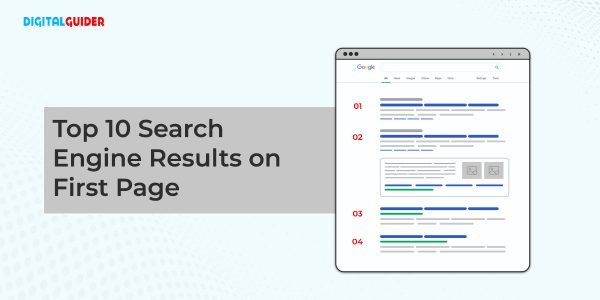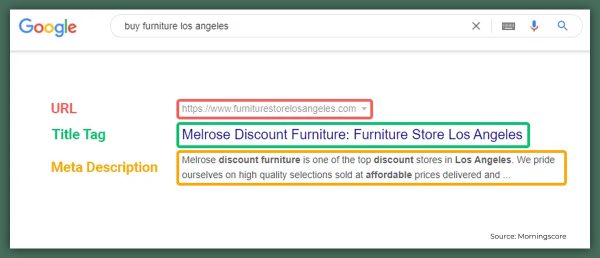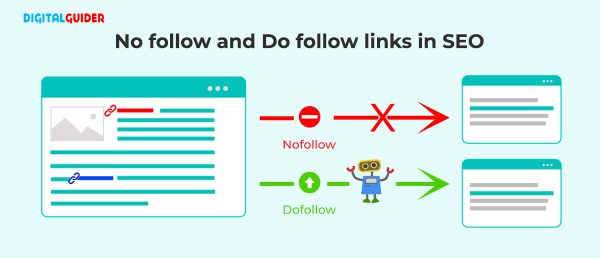You must have wondered why your competitor’s website consistently ranks higher on the first page of search engines. Indeed, the world of SEO is significant and a highly competitive space that might seem overwhelming. But here’s a secret: peeking at your competitors’ SEO strategy can make a big difference!
A thorough SEO competitive research & analysis will give you an overview of their strengths and weaknesses so you can tweak your SEO strategy accordingly.
SEO competitor analysis enables you to dive deep into what your competitors are doing with keywords, content, and backlinks in SEO and, second, use that (data-based) knowledge to improve your SEO campaign.
In other words, the goal is to understand how your competitors are implementing SEO strategies, what keywords they are targeting, the quality of their content, and the effectiveness of their backlink strategies.
Further, this guide will take you through the nitty-gritty of an SEO competitor analysis. By the end, you’ll be able to do this and boost your SEO game.
Why is Competitor Analysis in SEO so vital?
Often, businesses consider their direct market rivals (in their niche industry) as their only SEO competitors. However, the fact is that anyone who is writing for the web, for the products & services you deal with, is your online competitor.
For instance, a general informational website that doesn’t sell & might do affiliate marketing or an influencer’s website giving their reviews on products & services.
Hence, it becomes all the more important to analyze because you have more competition online than you thought earlier!
Identify your real online competitors!
SEO competitor analysis- How do you conduct it full-fledgedly?
1– Identify Your True SEO Rivals
 Identifying your niche competitors involves locating the top 10 websites in organic search results for your target keywords. You can recognize these competitors by conducting individual searches on search engines like Google for your target keywords & gain insights into their strategies.
Identifying your niche competitors involves locating the top 10 websites in organic search results for your target keywords. You can recognize these competitors by conducting individual searches on search engines like Google for your target keywords & gain insights into their strategies.
Analyzing their ranking positions, keyword choices, and overall performance helps you adapt and enhance your Search Engine Optimization approach. Now that you are fully aware of who your online competitors are, this is where an SEO competitive analysis should begin.
2– Close the Keyword Gaps & Gain an Edge

Source: Semrush
Through SEO competitor tools like Semrush, you can conduct keyword gaps. It means finding the keywords your website isn’t ranking for, but your competitors are. It’s like discovering the missing pieces in a puzzle. These words are opportunities to get more people to visit your site.
So, by adding these keywords, you improve your website and attract more visitors. This way, you have all the right words to be found easily online.
3– Conduct a Winning SWOT Analysis
Detect the strengths & weaknesses of your online competitors by considering these factors:
Domain Authority & Trust
Checking competitors’ authority scores is crucial when conducting competitor SEO analysis. In SEO, authority refers to the credibility and influence a website holds in the eyes of search engines.
It is often quantified through an Authority Score, which assesses the overall strength and reliability of a website’s content. This score considers factors such as the quality and quantity of backlinks, domain age, and content relevance.
Content Strategy Breakdown
Analyzing content is essential in SEO competitor analysis because content attracts visitors to a website. By looking at your competitors’ most successful pages, you don’t have to guess what content will attract the most visitors.
Scrutinize their web pages and look for patterns, such as whether the content is primarily long-form or short, if there are many videos or images, and whether they focus on product pages, blog posts, or something else.
Use your answers to these questions to guide the creation of your content. This approach removes guesswork and allows you to replicate what’s already successful but in an improved manner.
Technical SEO Planning

When conducting competitor analysis, checking technical SEO metrics is crucial because it reveals how well a competitor’s website is structured and optimized for search engines.
For example, examining page load times can help you understand if your competitor provides a faster and more user-friendly experience. Checking mobile-friendliness metrics is essential in a world where many users access websites on their phones. Additionally, assessing how well search engines index a competitor’s site gives insights into their overall search engine visibility.
By understanding and comparing these technical SEO metrics, you can identify improvement areas in your website and gain a competitive advantage in online rankings.
Explore New Keyword Opportunities
When conducting competitor analysis, you must check how well your SEO competitors rank for new keywords. This metric offers insights into their ability to adapt to changing trends and customer preferences.
For instance, if a competitor consistently ranks well for fresh keywords related to industry trends or new products, it indicates a proactive approach to SEO. By monitoring new keyword rankings of competitors, you can identify emerging opportunities and trends in your industry. Evaluate each keyword separately, considering the need for new pages like blog posts or product pages based on the specified search intent.
Recover Lost Keyword Rankings
When a competitor loses rankings for specific words, it’s a chance for your website to gain from it. This can happen due to changes in Google’s rules or other reasons. However, these lost keywords create an opportunity. If you have pages on your site targeting these keywords but not ranking well, you can make them better.
For instance, ensure the page aligns with what users are searching for, fix any issues with SEO on the page, like not having enough links, and update the content with newer information. This way, you can benefit from your competitor’s loss and improve your site.
4– Analyze Sites on a Page-by-Page Basis
Further, analyze competitor pages individually, especially those ranking for keywords you still need to target, and consider these crucial on-page SEO factors in your SEO competitor analysis.

Image Source: Morningscore
Optimizing Title Tags for Clicks
Title tags are important because they tell Google what your pages are about, and improving them is an easy way to enhance your rankings.
It’s helpful to check your competitors’ title tags, especially those outranking you, and consider how they use keywords, where they place them in the title, and if they include catchy words like “easy” or “best.”
Doing this lets you get ideas to improve your title tags and rankings.
Crafting Irresistible Meta Descriptions
A meta tag is a brief text that summarizes what a webpage is about and appears in the search results. Even though meta descriptions don’t directly affect how high a page ranks, they can influence how many people click on it. People often need to remember meta descriptions, especially on big websites. So, it’s essential to remember them.
Check how your SEO competitors use meta descriptions, see what works, and make changes to yours based on that. For example, you can include essential information about your page and make it attractive to encourage more clicks.
Structuring URLs for SEO Success
How your website’s addresses (URLs) are set up can make it easier or harder for people to move around and find what they’re looking for.
A URL structure should be easy to understand and well-organized. Look at how your competitors arrange their URLs, especially on pages that rank higher than yours. Ask yourself:
- Do they include keywords in their web addresses? If yes, how?
- Are their web addresses short and simple?
- Do their web addresses tell you what the page is about?
If you find ways to make your web addresses better, you can make changes so they are just as good as, or even better than, your competitors’ URLs. For example, add relevant keywords to your web addresses to make them more descriptive.
Content & Keyword Optimization Secrets
In your SEO competitor research, analyze the pages ranking higher than yours by reviewing their content.
Consider:
- How are they incorporating keywords throughout the page?
- Are there additional related words you could include in your content?
- Is the writing of high quality?
- Do they cover topics with a similar level of detail as you do?
By addressing these questions, you can enhance your content and strive to match or surpass your competitors’ pages.
Tip: Identify keyword usage patterns and improve your content to make it more comprehensive and valuable.
5– Analyzing User Interface & Design
Checking how a website looks and how easy it is to use is a crucial part of competitor analysis. This is known as analyzing the user interface and design. It’s like evaluating if a store is neat and if it’s simple to find what you’re looking for.
For example, you can look at your competitors’ websites and notice the colors they use, where the buttons are placed, and how easy it is to navigate. By understanding what works well on their sites, you can improve your website to make it more attractive and user-friendly for visitors.
6– Review Backlinks for SEO Competitor Analysis
Highly linked pages, especially from reputable and related websites, usually achieve better Google rankings. Analyzing backlinks is a crucial aspect of SEO competitor analysis, as a superior backlink profile can make it challenging to surpass competitors in rankings.
To evaluate your and your competitors’ backlinks, consider these three actions:
Comparison of Backlinks
Good backlinks come from websites that are trustworthy, important, and related to your topic.
For example, if a popular and reliable website links to your content, that’s a high-quality backlink. On the other hand, wrong or “toxic” backlinks are from websites that aren’t related or are questionable. If a strange or untrustworthy site links to yours, that’s a low-quality backlink.
Checking the kind of links your competitors have helps you understand how vital their online support is.
Monitor ‘Nofollow’ and ‘DoFollow’ Backlinks

Nofollow and Follow are like labels for website links. Nofollow tells search engines to ignore the link, like when you mention a competitor without officially endorsing them. Follow links are regular links without unique labels, and they can show support and help with SEO. These are the links you want for SEO value.
For example, if a popular site gives your competitor a Follow link, it can boost their SEO. Checking these links for your competitors helps you understand their online support better.
Finding Hidden Backlink Opportunities
Doing a backlink gap analysis means checking who links to your SEO competitors but not to you.
If someone supports your competitors, they might be willing to help you, too, especially if your content is better. It’s like seeing if there are people who mention your friends but not you and then asking if they would like to be friends with you, too.
7– Capture Featured Snippets

Take note of the exceptional results that appear in searches, like featured snippets, when analyzing what your competitors are doing. These are called SERP features. Aim to get these features for your website by providing information that Google finds valuable.
For example, if your competitor has a featured snippet for “healthy breakfast recipes,” you might create content on your site that could also be chosen as a featured snippet by Google.
8– Mobile Responsiveness
Check if your competitors’ websites are mobile-friendly, and ensure your site offers an equal or better mobile experience. This impacts users’ choices, potentially steering them towards your site.
Conversely, if your site is mobile-friendly, you can avoid losing traffic to competitors with optimized mobile sites. Use Google’s Mobile-Friendly Test to assess your and your SEO competitors’ mobile responsiveness by entering the domain’s root URL or a specific page URL into the search bar.
9– Schema Markup

Source:ahrefs
Schema markup is a code snippet supplying structured data to search engines, such as Google, enhancing their comprehension of page content. This leads to displaying rich snippets containing information like FAQs, business hours, and reviews in SERPs.
10– Local SEO considerations
When doing competitor analysis, it’s crucial to consider Local SEO, primarily if your business serves a specific area. Check your competitors’ Google My Business (GMB) profiles to see how they present themselves locally. Look at their reviews and ratings to understand what customers like or dislike.
Also, pay attention to local website keywords and check if they have consistent business citations.
Local SEO helps your business show up better in local searches, and by understanding what your competitors are doing locally, you can improve your local online presence.
Wrapping Up – Outranking the Competition
In the realm of SEO competitor analysis, what’s mentioned above is just scratching the surface. There’s much more to explore, but this is a solid starting point. You want to stay up to date when checking out what your competitors are doing with SEO campaigns. Understanding and learning from them helps you create a strong content plan, ensuring you do better. It’s like figuring out your place online.
With these insights, you can set goals and plan to stay ahead. If you need help with SEO competitor analysis, contact us—we’re here for you! All the best with your competitor analysis! May you steal a lost backlink or featured snippet of your competitor for your advantage!
FAQs – SEO Competitor Analysis
Q1. What is a competitive website analysis?
A1. The competitive website analysis provides an overview of the market position and strategies of all top players in the industry.
Q2. How Often Should I Perform SEO Competitor Analysis?
A2. Competitor Analysis should be done at least twice a year or even once a quarter.
Q3. How can I fill content gaps as per competitors?
A4. To fill content gaps based on competitors, you can conduct keyword research and include a CTA to analyze competitor content and customer feedback.
Q4. How do seasonal trends affect Competitors’ SEO?
A4. Seasonal trends can cause fluctuations in traffic; understanding these trends helps anticipate changes in competitor strategies.
Q5. How do I find competitors’ top-performing CTAs?
A5. You can find competitors’ top-performing CTAs by reviewing their landing pages and conversion rate optimization tools.
Q6. What is the best way to assess site security in SEO analysis?
A6. You can check competitors’ site security by looking for HTTPS usage and two-factor authentication. Also, review CMS updates and hosting details.
Q7. How does mobile optimization affect SEO competitor’s analysis?
A7. Evaluating competitors’ mobile-friendly strategies is important, as a mobile-optimized website can improve search rankings and user engagement.







